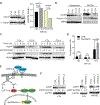Paradoxical Role for Wild-Type p53 in Driving Therapy Resistance in Melanoma
- PMID: 31836388
- PMCID: PMC7419227
- DOI: 10.1016/j.molcel.2019.11.009
Paradoxical Role for Wild-Type p53 in Driving Therapy Resistance in Melanoma
Erratum in
-
Paradoxical Role for Wild-Type p53 in Driving Therapy Resistance in Melanoma.Mol Cell. 2020 Feb 6;77(3):681. doi: 10.1016/j.molcel.2020.01.005. Mol Cell. 2020. PMID: 32032511 Free PMC article. No abstract available.
Abstract
Metastatic melanoma is an aggressive disease, despite recent improvements in therapy. Eradicating all melanoma cells even in drug-sensitive tumors is unsuccessful in patients because a subset of cells can transition to a slow-cycling state, rendering them resistant to most targeted therapy. It is still unclear what pathways define these subpopulations and promote this resistant phenotype. In the current study, we show that Wnt5A, a non-canonical Wnt ligand that drives a metastatic, therapy-resistant phenotype, stabilizes the half-life of p53 and uses p53 to initiate a slow-cycling state following stress (DNA damage, targeted therapy, and aging). Inhibiting p53 blocks the slow-cycling phenotype and sensitizes melanoma cells to BRAF/MEK inhibition. In vivo, this can be accomplished with a single dose of p53 inhibitor at the commencement of BRAF/MEK inhibitor therapy. These data suggest that taking the paradoxical approach of inhibiting rather than activating wild-type p53 may sensitize previously resistant metastatic melanoma cells to therapy.
Keywords: Wnt5A; aged microenvironment; melanoma; slow-cycling phenotype; therapy resistance; tumor microenvironment; wild-type 53.
Copyright © 2019 Elsevier Inc. All rights reserved.
Conflict of interest statement
Declaration of Interests The authors declare no competing interests.
Figures






References
Publication types
MeSH terms
Substances
Grants and funding
LinkOut - more resources
Full Text Sources
Medical
Molecular Biology Databases
Research Materials
Miscellaneous

